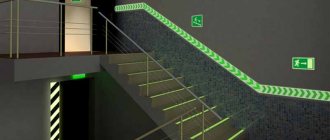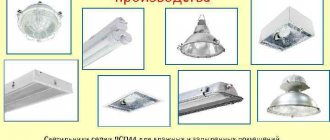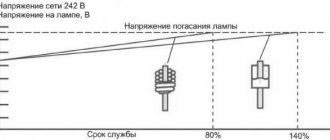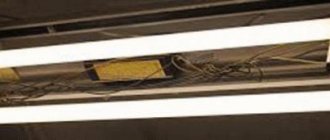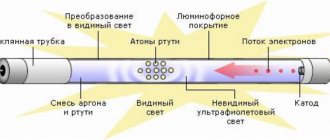For those who professionally install lighting, installing an emergency system is often a necessity. To ensure its high-quality operation, you need to understand the requirements that apply in such situations and know what you need to pay attention to when installing automatic emergency lighting.
Emergency lighting diagram Source katransb.ru
Operating principle of emergency lighting
When the main one is switched off due to an accident, the emergency lighting is turned on. To do this, automatic switches, one or more lighting devices and an autonomous power source must be installed. Various additional system elements will also be required for the system to operate.
The operating scheme must guarantee reliable operation and timely activation of the additional system. Usually it has less power compared to the main one. A typical list of devices used includes:
- two or more light bulbs;
- battery of suitable power;
- safety device;
- contacts for connecting relays;
- rectifier.
Usually the battery is connected to the network through a rectifier and is recharged, which occurs in a constant mode. In off-grid systems, the battery is the only source of energy. The service life at a temperature of +20 degrees must be at least 10 years.
Emergency lighting at the enterprise Source svetpro.ru
Centralized systems use electricity that comes from centralized sources - central battery installations, uninterruptible power supplies, a separately equipped input from the power supply system. Such sources are completely independent from the energy sources for main lighting.
Sometimes combination devices may be used. They have several light sources: for normal operation and for emergency use.
If lighting devices are used both in continuous and intermittent mode, then each of them must have a control device that provides for its separate switching on and off.
The system must have testing modes. They can be done at individual devices or provide for centralized verification. In this case, a shutdown of the main lighting network is simulated, as a result of which the emergency one should be turned on.
Using emergency signs Source vse-e.com
Where is emergency lighting installed?
Its installation occurs for evacuation purposes or to equip an additional source of lighting. In the first case, ensuring the safety of people's movement is one of the evacuation measures. In the second, we are talking about ensuring the possibility of uninterrupted operation in areas of critical infrastructure. It is important that the level of emergency lighting meets at least the minimum requirements for carrying out the activity.
Based on general requirements, such lighting should be installed in the following cases:
- At power plants that provide electricity to consumers.
- In rooms that are critical for the operation of heating systems.
- At pumping stations to ensure uninterrupted supply of cold and hot water to consumers.
- In rooms containing equipment that supports the functioning of the building's ventilation system.
- It is important to provide emergency lighting in areas where it is important to prevent fire. This is necessary even when the use of protective measures could lead to a shutdown of the entire process chain.
- Lighting to ensure the evacuation of people in emergency circumstances is necessary in any industrial buildings in areas where there is no natural light. If more than 50 people (for main rooms) or more than 100 (for additional rooms) will move along the aisle, then emergency lighting must be equipped regardless of the presence of natural light.
- The need for emergency lighting depends on the number of floors of the building. If there are 6 floors or more, then the implementation of the measure in question is mandatory.
- Additional light sources are mandatory in children's and medical institutions.
- In dormitories, the system in question is installed with passage lengths exceeding 25 meters. This measure is mandatory regardless of this length if the number of residents is at least 50.
- Emergency lighting must be installed in retail premises with an area of 90 square meters or more. meters.
- Its installation is mandatory in gyms, medical and preventive premises, baths, locker rooms, kitchens and some other public buildings.
- If there are more than 100 seats in the assembly hall, then the installation of such lighting becomes mandatory.
In these situations, it is necessary not only to install the equipment, but also to constantly monitor its performance. You need to be sure that in the event of a sudden emergency, the emergency lighting system will be fully operational.
Emergency lighting luminaires Source vse-e.com
Why do you need a battery?
A battery is needed to provide light sources with electrical energy. But, as mentioned above, not only batteries are used. The fact is that conventional batteries fail quite quickly and require replacement. New lithium-ion, lithium-polymer and lithium-cadmium batteries are durable, but quite expensive. Recently, supercapacitors, which can operate without maintenance for decades, have become increasingly common in LED lamps. In addition, they charge very quickly and have no leakage currents. As for the price, they are in the middle between conventional (lead or iron-nickel) and lithium-ion batteries.
Lamp disassembled: board with LEDs, battery, control board
Regulatory Requirements
The rules for installing emergency lighting networks are regulated in detail in Code of Rules 52.13330.2016. Here is a classification of types of artificial lighting, which includes the following types: working, security, duty and emergency. The latter refers to the following two varieties:
- Backup refers to processes that cannot be immediately stopped in the event of an emergency. In this case, there is a need to continue the activity, for which it is necessary to ensure a sufficient level of illumination. One example of such a situation would be when undergoing surgery.
- Evacuation lights are designed to illuminate passages along which people move during the evacuation process during emergencies.
The last option is divided into the following types:
- Illumination of the routes along which it is intended to evacuate in the event of a critical situation. An important feature of such lighting is that it works on an ongoing basis, and not just during an accident. This applies to most facilities where large numbers of people gather. These include large stores, schools, business centers and similar premises and similar places.
- Lighting of places that are associated with increased danger. Typically, this option is in demand at industrial enterprises.
- Anti-panic lighting provides good visibility of the passages along which people move when a critical situation arises. In its absence, the risk of panic increases. If there is a large crowd of people, they can trample each other.
In these cases, reliable operation and uninterrupted operation of emergency lighting must be ensured. Lamps to ensure evacuation can be located in various places: on the ceiling, on the walls and in other places, for example, on the steps of evacuation stairs.
How lighting should be positioned Source interalighting.ru
An emergency lighting system may be required in the following cases:
- There is a risk that people may get hurt. This may occur due to injury, poisoning or death in an accident.
- In case of fire or threat of fire.
- If there is a danger of explosion.
- If there is a danger of disruption to an important technological process.
- Due to the leakage of hazardous toxic substances or radioactive materials.
- In case of disruption of the activities of critical infrastructure facilities.
- When there is a threat to stop objects that cannot be interrupted.
In the event of an emergency, emergency lighting helps to cope with the consequences more effectively.
Types of light signs used Source interalighting.ru
Emergency lighting is installed in places that are least exposed to danger in the event of an emergency. Equipment for turning on and controlling the system is located in the most protected places.
To check readiness for work, you need to regularly check the serviceability of the equipment. In this case, you need to enable, disable and control its operation. In some cases, such inspections are part of an evacuation drill.
When installing an emergency lighting system, the requirements of the following documents must also be taken into account:
- SP 256.1325800.2016 regulates the performance of work related to working with electrical installations of various buildings.
- GOST-R-55-842.2013 contains requirements for ensuring the operation of emergency support.
The alternating current network, which should ensure the operation of the additional system, is laid parallel to the wires of the main system.
A distinction should be made between anti-panic and evacuation lighting. The first is intended to provide access to escape routes. The second is intended for their direct illumination.
Types of lamps
It is necessary to select lighting devices in such a way that they work as reliably as possible. To do this, you need to use only certain types of lamps:
- The use of incandescent lamps is permitted. But at the same time, only those that can work normally at minimum voltage are suitable.
- Fluorescent lamps can be used without a starter. Their use in emergency lighting is permissible only if the temperature in the corresponding place is not lower than +5 degrees. They must be provided with a voltage of at least 90% of the nominal voltage.
- The use of LED lamps is permissible in cases where they can operate in the appropriate voltage range, which is provided by the power supply used.
It is allowed to use separate lamps that have their own autonomous power supply. The choice of suitable lighting fixtures depends on the requirements for them and the conditions of use. The color rendering index for any type of lighting fixture Ra cannot be less than 40.
Fire safety evacuation sign Source ru.wikipedia.org
Sometimes a delay device is used in conjunction with the luminaire. When using it, the lighting does not turn on immediately when an emergency occurs, but after a delay specified during setup.
When using incandescent lamps, the following advantages should be noted:
- Relatively low cost of lighting fixtures.
- Easy to replace broken lamps.
However, the following disadvantages are worth noting:
- They have a short service life.
- These bulbs consume a lot of energy.
In most cases, emergency lamps involve the use of other types of lamps.
Fluorescent emergency lamp Source exit-svet.ru
Consumer groups
Everyone who uses emergency lighting can be divided into several main groups. Each of them will be discussed in more detail below.
Strategic objects
If an emergency occurs here, it could cause catastrophic consequences. We can talk about violations of state security, injuries or deaths of people, as well as other similar consequences.
In such cases, an independent backup power network is installed, which can provide the same power as in the main network. It uses lithium-ion batteries, as well as spare diesel engines and generators. It is possible to use other emergency sources. Capable of supplying the necessary voltage for lighting during the entire period of restoration of the strategic facility.
Industrial buildings
The consequences of accidents can be injuries to people, decreased production, and serious disruptions in the operation of equipment. Here it is also necessary to use an autonomous emergency system. Unlike the first category, short-term power outages are allowed during repair work.
Here it is necessary to ensure the ability to manually turn on the system by specially designated duty personnel. Most buildings for industrial or administrative purposes fall into this category.
LED emergency lamp Source s3.ru
Other objects
Here, a power outage is allowed for a period that does not exceed a day. In such rooms it is customary to use low-power lighting fixtures. The emergency lighting can be started automatically or manually. Typically, the backlight is activated when a fire alarm is received.
In small rooms, it is sometimes practiced to use separate autonomous emergency lamps. Each of them has its own power source. The batteries used in them are charged in advance from the network and at the time of an emergency they provide a sufficient level of lighting.
Advantages and disadvantages of use
The advantages of using LED emergency lamps are undeniably greater than the disadvantages. Nevertheless, they exist.
Among the advantages we can highlight:
- High reliability during operation, a serious level of protection against overloads and short circuits, unpretentiousness to sudden temperature changes.
- Increased service life. Compared to alternative emergency lighting sources, it is the highest.
- Minimized energy consumption, without loss of lighting intensity. The operating principle of LEDs allows you to create a bright beam of light with minimal energy consumption.
- Simple installation and ease of maintenance, a variety of models without loss in basic parameters.
The disadvantages include only one significant factor - the battery life is about five years (depending on the model), after which they must be replaced.
LED lamps are the most promising type of illumination devices today. Technical characteristics allow them to be used almost everywhere. Therefore, choosing them when creating effective emergency lighting will be technically and economically justified.
Useful tips Connection diagrams Principles of operation of devices Main concepts Meters from Energomer Precautions Incandescent lamps Video instructions for the master Testing with a multimeter
Switching method
Emergency lighting is turned on when the main one is turned off. In this case, a special relay reacts to a power failure, which turns on the emergency lighting system. This switch must be selected to operate reliably. If in an exceptional situation it does not work, then it will need to be turned on manually. This possibility must be provided when installing the lighting system.
Equipment designed to turn on or off the emergency lighting system must be located in a specially designated area. It must be accessible to personnel and protected from entry by unauthorized persons.
It is necessary that switches are located in fire-proof cabinets. Symbols should be provided to explain the use of the various elements.
Emergency lighting in the metro Source svetpro.ru
Maintenance and performance monitoring
A distinctive feature is the presence of a battery.
When commissioning, the battery must be charged for 24 hours. In the future, even if there is no need to turn it on, operation in emergency mode is required until the battery is completely drained. The time until complete discharge is recorded and if it differs from the indicators indicated in the passport by more than 30 percent, then the battery requires replacement. If everything is in order, the battery is charged again.
There are models that provide testing in a mode without turning off the main power. This makes it much easier to carry out equipment maintenance.
Requirements for lamps
When choosing lighting devices for emergency lighting, it is necessary to ensure not only timely switching on, but also trouble-free operation in difficult emergency conditions. In particular, it is necessary to ensure the functionality of the device at elevated temperatures. It is stipulated that the lamp must be such that it can withstand a temperature of 850 degrees. This requirement is specified in GOST No. 60598.
Products undergo such testing at the manufacturer. It is important to ensure that when the lamp melts, it does not affect the combustion of surrounding objects.
Some models do not start working because the main lighting system is turned off, but receive a command from the fire extinguishing system. They can only be used with a special certificate.
Autonomous emergency lamp with lithium-ton battery Source bast.ru
Installation of emergency lamps with battery
The design of emergency lamps with a battery is quite simple. The equipment consists of the following elements:
- Frame;
- Light diffuser;
- Power supply and battery;
- Reflector;
- LEDs or sockets with lamps;
- Wire with plug.
The frame can be made of the following materials:
- Polycarbonate;
- Stainless steel;
- Polyester resin;
- Aluminum alloy.
The light diffuser is made of polycarbonate or tempered glass. The reflector is a steel sheet coated with white paint. There are models in which the reflector is made of polished aluminum.
The choice of emergency LED lamp must be approached very carefully, since the health and lives of people may depend on it.
- LED lamps Office lighting
- Trade lighting
- Industrial lighting
- Street lighting
- Lighting for housing and communal services
- Emergency lighting
- Explosion-proof lighting
- Decorative lighting
- Phyto lamps
- Medical lighting
- Brackets
- Service and repair
Main types of emergency lighting
The algorithm described above is implemented for emergency LED lamps. During an emergency, the emergency LED light continues to burn at 10-20% power. And its operating time reaches up to 3 hours thanks to the battery.
The choice of emergency LED lamp must be approached very carefully, since the health and lives of people may depend on it.
Since the LED emergency lamp is equipped with a battery, it is necessary to perform a battery discharge-charge cycle at least once every six months to maintain it in working condition. Also, when performing this procedure, you will once again check the functionality of the emergency lighting system.
The most acceptable option today is LED emergency light sources. The modern market offers a huge number of similar devices, so there will be no problems with the search. These lighting devices have become so widespread because of their efficiency and safety.
Performing a check
The occurrence of an emergency situation is a rare event. However, legislation requires that such equipment be in good working order at all times. To do this, it is necessary not only to install it correctly, but also to regularly check the functionality of the system.
When installing emergency lighting, you need to connect the system being tested to a separate switchboard or through one or a group of circuit breakers to the main switchboard. If this is done in a different way, the inspector will record a violation, which will be included in the inspection report.
Emergency lighting panel Source sigmatek.by
Sometimes such a network belongs to the lessor. In such a situation, the tenant's inspection should not consider the correctness of its connection.
During the verification process, the main network machine is turned off or on, which simulates the occurrence of an emergency. In this case, the emergency lighting must demonstrate its functionality.
Emergency lighting of a substation Source ampervolt.kz
Then the main network is launched. As a result, the emergency system should stop working. Based on the results of the inspection, an act is drawn up, which should reflect the results. In particular, it records the number of lamps, indicating the number of working ones, as well as non-working ones. Regarding the latter, an additional check is performed to determine the cause of the malfunction. It includes the following steps:
- Checking the presence of zero and phase at the corresponding terminals.
- The serviceability of the lamp is monitored. If it doesn't work, it needs to be replaced.
In some cases, the emergency lighting network is not separated. In this case, the main lighting is turned off to check. In this case, emergency lamps should work normally. However, the fact of the absence of a backup line is recorded, which is reflected in the documents.
Lighting in a large store Source specteh-krasnodar.speczakaz.info
